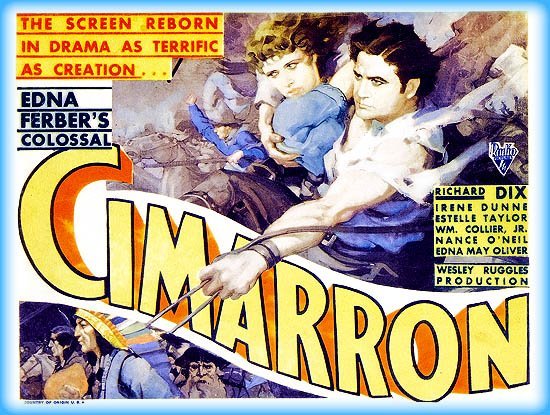Inspired by his adventures during the 1889 Oklahoma land rush, Yancey Cravat, a freewheeling lawyer and newspaper editor, convinces his Eastern-bred wife Sabra to leave her stuffy Wichita family and join him in the West. Although Sabra finds Osage, the Oklahoma “boomer town” that Yancey has chosen to start his newspaper, rough and squalid, she settles there with him and, with help from their young black servant Isaiah, undertakes to bring up her son “Cim.” Soon after his arrival, Yancey confronts local outlaw and bully Lon Yountis with the murder of the newspaper’s previous editor. During an “all-faiths church meeting,” which Yancey has been asked to conduct at the town gambling hall, Yancey threatens to identify the editor’s killer and is shot at by Lon. In self-defense, Yancey kills Lon, then dismisses his “flock,” which includes Dixie Lee, a maligned prostitute whom Yancey had befriended during the land rush. A year later, after the birth of the Cravats’ daughter Donna, Osage is besieged by an outlaw gang led by The Kid, an old cowboy friend of Yancey’s. Although Yancey kills The Kid during a fierce gun battle, which also claims the life of the loyal Isaiah, he refuses to collect any reward for his deed and bemoans The Kid’s downfall. In 1893, a new “Cherokee Strip” land rush is announced, and Yancey, who has never stayed in one place for more than five years, deserts the much-settled Sabra to participate in it. Helped and supported by expert printer Jesse Rickey and department store owner Sol Levy, Sabra, who knows nothing of Yancey’s whereabouts, takes over the newspaper. Five years later, dressed in a “Rough Riders” uniform, Yancey returns to Osage just as Sabra and a group of “decent women” are about to try Dixie Lee as a “public nuisance.” Yancey successfully defends the misunderstood Dixie in court, then convinces his less tolerant wife of Dixie’s essential goodness. After Oklahoma obtains statehood in 1907 and the oil boom has brought prosperity to some of the Osage Indians, Yancey, who has been approached to participate in a political scheme to trick the Indians out of their wealth, writes a provocative editorial favoring citizenship for all American Indians. Despite the heated objections of Sabra, who has always loathed the Indians and who is repulsed by her son’s romantic involvement with an Indian chief’s daughter, Yancey publishes the editorial and then disappears. Many years later, after the fortieth anniversary of the newspaper’s founding, Sabra is elected as Oklahoma’s first Congresswoman. During a luncheon in her honor, a more tolerant Sabra speaks fondly of her Indian daughter-in-law and her long-lost husband. Just before she is to dedicate a statue honoring the Oklahoma pioneers, Sabra hears that a tramp called “Old Yance” has risked his own life to save many oil drillers from a deadly explosion. Sabra rushes to the accident site in time to embrace Yancey before his death, then discovers that the statue has been sculpted in his image. The following statement is included in the film’s opening credits: “For certain descriptive passages in Cimarron Miss Ferber makes acknowledgement to Hands Up by Fred E. Sutton and A. B. MacDonald.” Sutton and MacDonald’s novel was published in New York in 1927. According to an Oct 1932 LAEx news item, the studio bid $125,000 for the rights to Ferber’s novel. That amount, which was also paid by Universal for the rights to Strictly Dishonorable, also produced in 1931 (see AFI Catalog of Feature Films, 1931-40; F3.4369), was the highest ever paid by motion picture companies for rights to literary properties, according to the news item. The picture’s famous land rush scene, which required a week to film, was shot at Jasmin Quinn Ranch near Bakersfield, CA, according to studio production files. Publicity for the picture notes that 5,000 extras participated in that scene and forty-seven cameras were used to shoot it. An IP articles states that the land rush scene was shot by twenty-eight cameramen, six stillmen and twenty-seven assistants, to make a total camera crew of sixty-one, one of the largest group of cameramen ever assembled for one sequence. According to publicity, the Native Americans who appeared in the film were “made up white to appear coppery on the screen.” Production files indicate that the film cost $1,434,800 to produce and went over budget by $354,114. Modern sources state that the picture lost $565,000 at the box office in its initial release. Some of this loss was recouped in a 1935 re-issue. The film had its premiere at the Globe Theater in New York, where the top ticket price was $2.00. Cimarron won Academy Awards for Best Picture, Best Adaptation and Best Art Direction. It was nominated for Best Direction, Best Actor (Richard Dix), Best Actress (Irene Dunne) and Best Cinematography. FDYB included the film in its “one of the year’s ten best pictures” list.
Modern sources add the following cast credits: Clara Hunt (Indian girl), Bob Kortman (Killer) and Dennis O’Keefe (who at that time was known as Bud Flanagan ). William Janney is identified in the role of a “worker” by modern sources. In 1960 Anthony Mann directed Glenn Ford and Maria Schell in an M-G-M version of Ferber’s novel (see below). More on Wikipedia
Watch Cimarron (1931)






